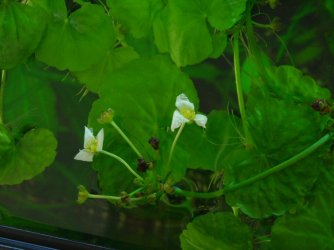Hi everyone. A couple of weeks ago I noticed that one of my amazon swords was sending up a thin shoot that wasn't a new leaf. After looking more closely I realised it was 'flowering'
I now have two shoots and several 'plantlets'. The little plantlets are now developing roots and leaves of their own and I'm now wondering what to do.
I've only ever come across this once before with a different type of Echinodorus (an Ozelot type) and once I removed the plantlets on that the mother plant died.
The last thing I want to happen with my sword is the same thing.
Can anyone please advise me of what I do next? There's at least 6 or 7 plantlets growing on the two storks
I now have two shoots and several 'plantlets'. The little plantlets are now developing roots and leaves of their own and I'm now wondering what to do.
I've only ever come across this once before with a different type of Echinodorus (an Ozelot type) and once I removed the plantlets on that the mother plant died.
The last thing I want to happen with my sword is the same thing.
Can anyone please advise me of what I do next? There's at least 6 or 7 plantlets growing on the two storks




